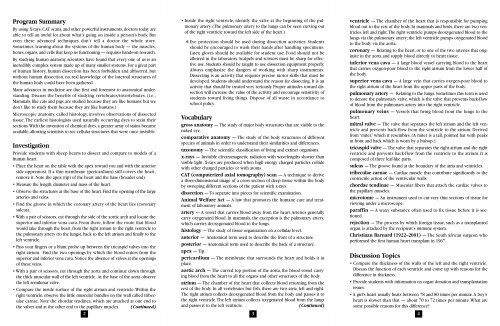Comparative Anatomy: Dissection - Classroom Science Resources
Comparative Anatomy: Dissection - Classroom Science Resources
Comparative Anatomy: Dissection - Classroom Science Resources
You also want an ePaper? Increase the reach of your titles
YUMPU automatically turns print PDFs into web optimized ePapers that Google loves.
• Inside the right ventricle, identify the valve at the beginning of the pulmonary<br />
artery. (The pulmonary artery to the lungs can be seen curving out<br />
of the right ventricle toward the left side of the heart.)<br />
*<br />
2 3<br />
Eye protection should be used during dissection activities. Students<br />
Program Summary<br />
By using X-rays, CAT scans, and other powerful instruments, doctors today are<br />
able to tell an awful lot about what’s going on inside a person’s body. But<br />
even these advanced techniques don’t tell a doctor the whole story.<br />
Sometimes, learning about the systems of the human body — the muscles,<br />
should be encouraged to wash their hands after handling specimens.<br />
bones, organs, and cells that keep us functioning — requires hands-on research.<br />
Latex gloves should be available for student use. Food should not be<br />
By studying human anatomy, scientists have found that every one of us is an<br />
allowed in the laboratory. Scalpels and scissors must be sharp for effec-<br />
incredibly complex system made up of many smaller systems. For a great part<br />
tive use. Students should be taught to use dissection equipment properly.<br />
of human history, human dissection has been forbidden and abhorred, but<br />
Always emphasize the dangers of working with sharp instruments.<br />
without human dissection, no real knowledge of the internal structures of<br />
the human body could have been gathered.<br />
Many advances in medicine are due first and foremost to anatomical understanding.<br />
Discuss the benefits of studying vertebrates/invertebrates. (i.e.,<br />
Mammals, like cats and pigs, are studied because they are like humans; but we<br />
don’t like to study them because they are like humans.)<br />
Dissecting is an activity that requires precise motor skills that must be<br />
developed. Students should understand the reason for dissecting. It is an<br />
activity that should be treated very seriously. Proper attitudes toward dissection<br />
will increase the value of the activity and encourage sensitivity of<br />
students toward living things. Dispose of all waste in accordance to<br />
school policy.<br />
Microscopic anatomy, called histology, involves observations of dissected<br />
tissue.The earliest histologists used naturally occurring dyes to stain their<br />
sections.With the invention of chemical dyes, a greater array of stains became<br />
available, allowing scientists to see cellular structures that were once invisible.<br />
Vocabulary<br />
gross anatomy — The study of major body structures that are visible to the<br />
naked eye.<br />
comparative anatomy — The study of the body structures of different<br />
Investigation<br />
Provide students with sheep hearts to dissect and compare to models of a<br />
human heart.<br />
• Place the heart on the table with the apex toward you and with the anterior<br />
side uppermost. If a thin membrane (pericardium) still covers the heart,<br />
remove it. Note the apex (tip) of the heart and the base (broader end).<br />
• Measure the length, diameter and mass of the heart.<br />
species of animals in order to understand their similarities and differences.<br />
taxonomy — The scientific classification of living and extinct organisms.<br />
x-rays — Invisible electromagnetic radiation with wavelengths shorter than<br />
visible light. X-rays are produced when high energy charged particles collide<br />
with other charged particles or with atoms.<br />
CAT (computerized axial tomography) scan — A technique to derive<br />
a three-dimensional image of a cross section of deep tissue within the body<br />
by sweeping different sections of the patient with x-rays.<br />
• Observe the structures at the base of the heart. Find the opening of the large<br />
arteries and veins.<br />
• Find the groove in which the coronary artery of the heart lies (coronary<br />
sulcus).<br />
• With a pair of scissors, cut through the side of the aortic arch and locate the<br />
superior and inferior vena cava. From there, follow the route that blood<br />
would take through the heart, from the right atrium to the right ventricle to<br />
the pulmonary artery (to the lungs), back to the left atrium and finally to the<br />
left ventricle.<br />
• Pass your fingers or a blunt probe up between the tricuspid valves into the<br />
right atrium. Find the two openings by which the blood enters from the<br />
dissection — To separate into pieces for scientific examination.<br />
Animal Welfare Act — A law that promotes the humane care and treatment<br />
of laboratory animals.<br />
artery — A vessel that carries blood away from the heart.Arteries generally<br />
carry oxygenated blood. In mammals, the exception is the pulmonary artery,<br />
which carries deoxygenated blood to the lungs.<br />
histology — The study of tissue organization on a cellular level.<br />
anterior — Anatomical term used to describe the front of a structure.<br />
posterior — Anatomical term used to describe the back of a structure.<br />
apex — Tip.<br />
superior and inferior vena cava. Notice the absence of valves at the openings<br />
pericardium — The membrane that surrounds the heart and holds it in<br />
of these veins.<br />
place.<br />
• With a pair of scissors, cut through the aorta and continue down through<br />
aortic arch — The curved top portion of the aorta, the blood vessel carry-<br />
the thick muscular wall of the left ventricle. At the base of the aorta observe<br />
ing blood from the heart to all the organs and other structures of the body.<br />
the left semilunar valve.<br />
atrium — The chamber of the heart that collects blood returning from the<br />
• Compare the inside surface of the right atrium and ventricle.Within the<br />
rest of the body. In all vertebrates but fish, there are two atria, left and right.<br />
right ventricle, observe the little muscular bundles on the wall called tribec-<br />
The right atrium collects deoxygenated blood from the body and passes it to<br />
ulae carnae. Note the chordae tendinea, which are attached at one end to<br />
the right ventricle.The left atrium collects oxygenated blood from the lungs<br />
the valves and at the other end to the papillary muscles. (Continued)<br />
and passes it to the left ventricle. (Continued)<br />
ventricle — The chamber of the heart that is responsible for pumping<br />
blood out to the rest of the body. In mammals and birds, there are two ventricles,<br />
left and right.The right ventricle pumps deoxygenated blood to the<br />
lungs via the pulmonary artery; the left ventricle pumps oxygenated blood<br />
to the body via the aorta.<br />
coronary — Relating to the heart, or to one of the two arteries that originate<br />
in the aorta and supply blood directly to heart tissue.<br />
inferior vena cava — A large blood vessel carrying blood to the heart<br />
that carries oxygen-poor blood to the right atrium from the lower half of<br />
the body.<br />
superior vena cava — A large vein that carries oxygen-poor blood to<br />
the right atrium of the heart from the upper parts of the body.<br />
pulmonary artery — Relating to the lungs. Sometimes this term is used<br />
to denote the pulmonary valve, which is the valve that prevents back-flow<br />
of blood from the pulmonary artery into the right ventricle.<br />
pulmonary veins — Vessels that bring blood from the lungs to the<br />
heart.<br />
mitral valve — The valve that separates the left atrium and the left ventricle<br />
and prevents back-flow from the ventricle to the atrium. Derived<br />
from “miter,” which it resembles. (A miter is a tall, pointed hat with peaks<br />
in front and back which is worn by a bishop.)<br />
tricuspid valve — The valve that separates the right atrium and the right<br />
ventricle and prevents back-flow from the ventricle to the atrium. It is<br />
composed of three leaf-like parts.<br />
sulcus — The groove found at the boundary of the atria and ventricles.<br />
tribeculae carnae — Cardiac muscle that contribute significantly to the<br />
contractile action of the ventricular walls.<br />
chordae tendinae — Muscular fibers that attach the cardiac valves to<br />
the papillary muscles.<br />
microtome — An instrument used to cut very thin sections of tissue for<br />
viewing under a microscope.<br />
paraffin — A waxy substance often used to fix tissue before it is sectioned.<br />
rejection — The process by which foreign tissue, such as a transplanted<br />
organ, is attacked by the recipient’s immune system.<br />
Christiaan Barnard (1922–2001) — The South African surgeon who<br />
performed the first human heart transplant in 1967.<br />
Discussion Topics<br />
• Compare the thickness of the walls of the left and the right ventricle.<br />
Discuss the function of each ventricle and come up with reasons for the<br />
difference in thickness.<br />
• Provide students with information on organ donation and transplantation<br />
issues.<br />
• A girl’s heart usually beats between 78 and 80 times per minute.A boy’s<br />
heart is slower than that — about 70 to 72 times per minute.What are<br />
some possible reasons for this difference?<br />
4






